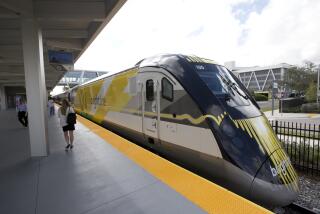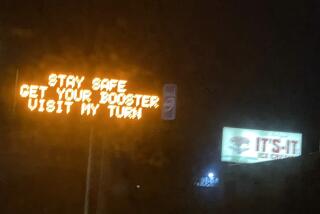High-tech train safety effort is approved
A collision-avoidance system that transportation safety board investigators say could have prevented the fatal collision of two trains in Placentia nearly five years ago was approved for use on freight trains by federal regulators Monday.
The system, called positive train control, will warn crew members of dangerous situations and automatically apply the brakes if they fail to act.
Under the plan approved by the Federal Railroad Administration, the system will be installed by Burlington Northern Santa Fe Railway Co. on 35 routes in 17 states, but not in California, in the first widespread application of the warning system for a freight railroad.
“This marks a new era of rail safety,” said Federal Railroad Administrator Joseph H. Boardman. “The steps the FRA and railroads are taking show that applying positive train control can work and will provide important safety benefits.”
The system has been recommended for development by the National Transportation Safety Board for nearly 30 years. In 1990, the agency added the technology to its list of most-wanted safety improvements for the transportation industry.
Burlington Northern, which has been running pilot programs in the Midwest since 2003, will combine digital communications with global positioning systems to monitor train locations and speeds.
Locomotive cabs will be equipped with computers capable of warning crew members of a problem and setting the brakes if they don’t respond.
Burlington Northern’s system can detect speed-limit violations, improperly aligned switches, unauthorized train movements and whether trains are on the wrong track or have missed warning signals. It will not warn crews about obstacles on tracks.
Company officials say they plan to apply the technology to about 6,300 miles of track, roughly 15% of BNSF’s network. The railroad is one of the largest in the nation, operating in 28 states, along with two Canadian provinces.
Among the states in which the system will be deployed are Washington, Arizona, New Mexico, Colorado, Wyoming, Montana and Texas. The system will be evaluated there, and expansion, to other states, including California, will require federal approval.
Similar collision avoidance systems are being tested by other major railroads.
“Labor has called for this for a long, long time. If the technology is at a point where the Federal Railroad Administration is satisfied, that is a good thing, but it is long overdue,” said William Keppen, a railroad consultant based in Annapolis, Md.
For almost 30 years, the NTSB has investigated a long list of train accidents in which crew members failed to operate their trains safely because of fatigue, sleep disorders, medications, inattentiveness or mistakes in judgment. In those accidents, the NTSB stated repeatedly that an automated warning system was necessary to compensate for human error.
Agency officials said the Placentia crash on April 23, 2002, highlighted the issue, and they reiterated the need for positive train control, particularly on high-risk corridors where passenger trains operate. Three passengers died and more than 260 were injured when a freight train collided with a Metrolink commuter train.
NTSB investigators concluded that the Burlington Northern engineer and conductor were talking to each other and failed to see a yellow warning signal, a problem that a collision avoidance system would have detected.
“We are encouraged that the industry is finally implementing this technology,” said Bob Chipkevich, who heads the NTSB’s office of railroad, pipeline and hazardous-materials investigations.
The NTSB has rated the Federal Railroad Administration’s response to its recommendations as “acceptable but progressing slowly.” The NTSB cannot order federal agencies to adopt its recommendations.
Railroad industry representatives said developing positive train control had taken so long because of high costs and reliability problems. Hundreds of millions of dollars have been invested in research, they said.
Railroad unions, such as the United Transportation Union and the Brotherhood of Locomotive Engineers and Trainmen, support positive train control as a safety measure.
They fear, however, that railroad companies might try to use the advancement as a reason to cut the size of freight train crews from at least two to a single person, who would serve as both engineer and conductor.
dan.weikel@latimes.com
More to Read
Start your day right
Sign up for Essential California for news, features and recommendations from the L.A. Times and beyond in your inbox six days a week.
You may occasionally receive promotional content from the Los Angeles Times.







